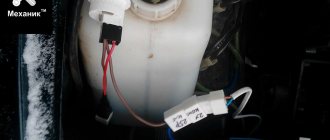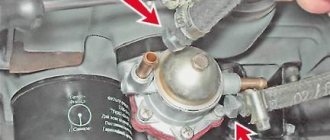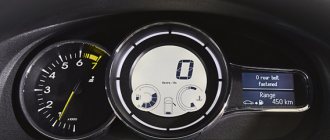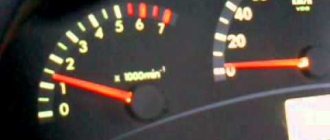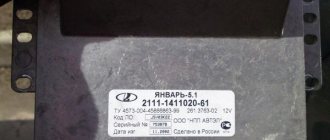Gasoline fuel is a fraction made from petroleum and is used as vehicle fuel. The main and most valuable feature is the ability to easily mix with air. Of all types of flammable liquids, it has the greatest resistance to frost. Many car enthusiasts have wondered, what is the freezing point of gasoline? Under conditions of absolute quality, the absence of additives and additives, the average value of the thermometer column at which AI freezes - 92, 95, 98 is equal to -72 °C.
Do not think that the substance turns into ice; the fuel becomes a jelly-like consistency. According to the laws of physics, in this state of aggregation the ability to mix with air is lost and the liquid loses its basic properties. Does gasoline freeze in the cold? In the middle zone, where winter is not so severe, fuel will not be able to freeze. If your car runs on diesel fuel, you should know that diesel freezes at -35°C. Be careful, as in the northern and central regions of Russia these are quite real frosts for the winter period.
Freezing point of gasoline and diesel fuel.
Can gasoline or diesel fuel freeze? - this question is relevant, especially in winter and especially in our country. Doesn’t such a phenomenon contradict the laws of physics, and what temperature should be for this to happen?
The chemical composition of oil speaks for itself if you know the second name of this “fossil” - hydrocarbon. Accordingly, this liquid consists of 85% carbon and 15% hydrogen! However, there is no exact formula for oil! Or rather, it is different and depends on the composition and number of compounds. Different types of fuel are obtained from oil - gasoline, diesel fuel and kerosene.
Unlike diesel fuel, gasoline is more volatile, evaporates faster and is more toxic. It is made from oil by direct distillation or by cracking, which can be catalytic or thermal. The latter option is more progressive, since the amount of fuel produced is 4–5 times greater than by distillation, and its quality at the end is much higher.
Additives (additives)
Improving quality by adding additives, which has been a common practice for gasoline for many years, has recently become popular for diesel fuel (Super and Premiom diesel fuels). The main additives used are those that have multiple effects:
- additives to improve ignition increase the cetane number and are responsible, in particular, for a “softer” combustion;
- detergents are used to prevent coking of injectors;
- corrosion inhibitors (retarders) are necessary to prevent corrosion of metal parts (if water gets into the fuel system);
- Antifoaming additives serve to facilitate filling the fuel tank.
The total concentration of additives usually does not exceed 0.1%!, so that the physical characteristics of the fuel such as density, viscosity and boiling curve do not change.
Freezing point of gasoline.
Oil thickens at minus 25-30 °C. As for gasoline, it can withstand lower temperatures without changing its state.
Residents of the middle zone, where there are no severe frosts and the lowest air temperatures range from 20 to 35 °C, should not worry, since in such frost the gasoline in the tank cannot simply physically freeze.
But we are talking about high-quality gasoline that meets all current standards. In turn, the quality of the fuel depends on the so-called additives it contains, the method of production and filtration. If you believe generally accepted information, such popular brands of gasoline as AI-92, AI-95 and AI-98 have a low freezing threshold, which starts at 72 °C! Therefore, theoretically, they are only able to freeze at the Earth’s poles. There is also information that premium fuels, such as EURO-6 and the like, freeze only at very low temperatures - below minus 118 °C. It has been experimentally proven that this temperature of gasoline turns it into a thick jelly.
That is why in the Arctic they use a special gasoline called “Arctic”. Special formulas help it remain liquid down to minus 150 degrees Celsius!
Such a property of fuel as not freezing is important, but much more important is its ability to ignite. An indicator such as gasoline viscosity is regulated by GOST and indicates the presence of sulfur and the starting temperature of ignition or the so-called flash in the engine. GOST allows a viscosity at which gasoline ignites, there is no thickening and the temperature threshold is minus 62 °C.
Tightness
If the container is not sealed, the fuel will evaporate. Moreover, the higher the temperature, the faster. Gasoline contains highly evaporating fractions that increase the octane number. Ensure tightness and you will preserve the quality of stored fuel longer.
To reduce interaction with air, containers must be filled with fuel to 95 percent.
In addition, when interacting with air, gasoline will oxidize. The use of oxidized fuel reduces the service life of vehicle systems, leads to the deposition of resins inside the engine, carbon deposits in the cylinders and on spark plugs.
No fuel supplied. What to do?
If there is no supply of gasoline from the tank to the injector and carburetor, then freezing of the fuel has nothing to do with it, and everything happens this way because it is of low quality or it is the fault of the car owner himself.
It follows from this that we may encounter unscrupulous gas stations along the way. On them, gasoline can be supplemented with diesel or water, even oil or fuel oil, and it’s not even clear what. But there are more or less conscientious gas stations that we should all strive to get to...
It is worth noting that it is especially dangerous to refuel with gasoline in sub-zero temperatures. The fact is that when it is warm, water and other harmful impurities settle to the bottom of the tank and are retained by the filter mesh. This way they are filtered and the engine is not affected.
But in frosty weather everything happens much worse. Water freezes, summer diesel fuel, and other petrochemical products also thicken. As a result, a thick film forms on the filter, which delays the flow of fuel! This can happen to any car.
Storage containers
Considering the fact that the shelf life of gasoline in a car tank is short, fuel can be stored in special cans and metal barrels. Some car owners store fuel in plastic bottles, but it is better not to do this, as gasoline reacts with plastic and accumulates a static charge. This happens very slowly, but plastic containers are still not suitable for storage. Theoretically, if a static charge accumulates, a spark may occur when gasoline is poured from a plastic container into the tank. Therefore, it is prohibited to store fuel in this manner.
Otherwise, the shelf life of gasoline in plastic containers will be approximately the same as in metal containers.
- Above ground metal tanks.
- Tankers and barrels.
- Buried tanks.
- Canisters.
As for storing gasoline in a canister, this is allowed, but the shelf life of the fuel in this case will be short. The best option is a tank buried in the ground, which is hidden from the sun and cooled by the soil. At home, people often resort to another option: they bury a metal barrel in the ground and seal it with a lid. This option for a permanent fuel tank is not bad.
Problem with the fuel pump.
If the fuel pump does not pump fuel, remove and clean the filter. It wouldn't hurt to clean the tank too. After these cleaning measures, in almost all cases the operation of the fuel pump will be restored. Freezing is only possible in severe frosts!
But sometimes drivers themselves can, through their actions, allow water and other unwanted impurities to get into the fuel. For example, if they refuel their car in the rain or snow and use a canister with a regular funnel. And if something has accumulated at the bottom of the canister, for example, rust, and there is no mesh on the funnel, then everything will go straight into the fuel tank. Conclusion: gasoline should be poured into the tank only using a special funnel with a mesh on it.
Kinds
All the most common types of gasoline are produced in 2 versions: winter and summer. They differ from each other like day and night. Due to various additives. If in the summer they try to lower the boiling threshold, then in the winter they lower the thickening threshold. At the same time, you still need to manage not to violate the threshold of its flammability. Otherwise, gasoline will turn from fuel into a useless antifreeze liquid poured into your tank. Drivers' love for switching from summer to winter fuel by refueling leads to a lot of problems.
Such as freezing of the fuel filter and the appearance of ice in the float chamber. Remember, a winter-summer gasoline cocktail freezes perfectly even at -9°C. But still, most often the culprits in the appearance of such cocktails are dressings. Where they also like to mix these gasolines.
The diesel fuel is frozen. What to do?
Winter diesel fuel differs from summer diesel fuel in having less paraffin additives. In cold weather, paraffin additives cool and turn into a solid state, forming a precipitate. At the first stage of this process, diesel fuel becomes cloudy, which in itself is not harmful, but as it cools, the molecular composition of the paraffins crystallizes. As the crystals grow, they begin to get stuck in the fuel filter in a gel-like state and block the flow of fuel. As a result, it does not enter the engine.
The quality of winter diesel fuel in the cold depends on its behavior at different temperatures. Maximum filterability occurs after the turbidity stage, and it is the onset of this stage at a certain temperature that characterizes the quality indicators.
Summer diesel fuel reaches its freezing point at minus 5 °C, while winter diesel fuel only reaches minus 35 °C. More than 40% of summer diesel fuel is obtained from summer oil, while winter diesel fuel is much less - only 25%. Of course, you will have to pay more money for winter diesel fuel. Therefore, in order to make money, unscrupulous gas stations dilute expensive diesel fuel with a cheaper option.
To prevent diesel fuel from reaching its pour point even at slightly sub-zero temperatures, a special additive is used - antigel, which, when added, makes it impossible to crystallize the paraffin suspension. In addition, this additive further reduces the amount of smoke in the exhaust.
Note that the antigel only works until the diesel fuel freezes. But if you do not have such an additive on hand, as a last resort, it is permissible to use kerosene. In the most critical situation, brake fluid is added (in the proportion of 100 ml per 100 liters).
If diesel fuel has already frozen, then there is a special tool that will defrost it. But if there is no special equipment either, then a heat source will help you, with the exception of direct exposure to flame. For example, exhaust gases coming from another car or hot water being poured onto the fuel tank.
Does it freeze?
In physics there is such a thing as absolute zero. It is equal to -273°C. So, under these conditions, absolutely everything will freeze. But since you and I do not encounter absolute zero, then there is accordingly nothing to be afraid of. Under our conditions, freezing (that is, crystallization) of gasoline is impossible. But with a certain decrease in temperature it begins to thicken. It turns into a viscous jelly-like mass. So, it is precisely the temperature of transition to critical thickening (-60°C) that is conventionally called freezing.
In this form, gasoline is absolutely impossible to pump through the fuel system. For areas where there is a risk of such temperatures, a special type of gasoline called “Arctic” is produced.
Reviews and recommendations from car owners.
Ivan: From personal observation, I will say that the critical temperature for summer diesel fuel is minus 10 °C, and at minus 10-15 °C problems begin with the fuel filter - it becomes clogged with thick paraffin flakes. In the 90s, foreign cars running on diesel fuel were already equipped with a heated fuel filter. Nowadays, diesel fuel is often bad and you can’t get enough anti-gel for it. Therefore, I chose one gas station, where they more or less don’t fill up, and that’s the only place I refuel.
Vladimir Evgenievich: I had such a problem once and it was only minus two. No fuel was supplied. I had to unscrew the tubes with the mesh from the tank. I immediately saw some kind of lump of matter with ice pieces on the mesh. Maybe even earlier liquid got into the tank along with this rag. Now I don’t lose my vigilance, I often look into the filter.
Egor: I consider diesel fuel a waste product from oil refining. If it is clean, without any impurities, then at our usual winter temperatures it cannot freeze. Gasoline will not freeze even at minus 40.
But if any obscene rubbish is added to diesel, for example paraffin or water (we often do this at gas stations), then minus 20 will be enough to freeze. Then both the engine and the car owner will have problems.
Sergey: Different types of fuel have their own temperature regimes. So summer diesel fuel is designed for operation within - 5 to - 7 degrees.
Winter - it will freeze already at -30 - -35 degrees.
Special, Arctic - only at - 50 degrees.
All car owners should know this so that they don’t have any difficulties or troubles in cold weather.
Didn't find the information you are looking for? on our forum.
How Fuel Octane Number Affects Knock: Exactly Explained
If you are hesitant and wondering what kind of gasoline is best to put in the tank of your car, the main thing we can advise you is not to overdo it! You should not experiment with AI-95 if, according to the passport, the car runs on AI-92. There is also no need to tempt fate and try to do the opposite by pouring gasoline with a reduced octane number to the edge of the neck. And so on, the variability of fuel brands allows you to make a choice, but will it be conscious and correct?
For example, take such a well-known concept as the octane number of fuel. We once wrote a short note about this, in which we explained what octane number is and what cetane number is: Octane and cetane number: what is the difference?
Is it definitely an important indicator of fuel? Of course, it is, because the octane number is an indicator that characterizes the detonation resistance of gasoline, that is, the ability of the fuel to resist spontaneous ignition during compression.
In other words, gasoline with a higher octane rating can be compressed to a higher pressure without spontaneous ignition of the air-fuel mixture.
Does this mean that high-octane gasoline will always be the best choice for any car? No, this option is not suitable for everyone, and now we will explain why gasoline with this higher rating is not suitable for all cars and why it will not store a higher charge of energy.
Octane number, if we translate the term into human language, is a kind of indicator of impact resistance, not explosive power. The higher the octane number, the less likely it is for the fuel to ignite prematurely. That is, higher octane gasoline does not contain additional energy as such, it’s just that engines of a certain design are able to squeeze more energy out of such fuel, burning a larger amount of the air-fuel mixture per unit of time.
But, firstly, this is only possible if the engine of your car is designed in a certain way: as a rule, it is equipped with a turbocharger or has a very high compression ratio. Secondly, it works without failures and does not have any acquired during operation serious problems.
There is also no difference in the combustion rate of 92, 95, 98 gasoline. Different octane types of fuel also do not differ in “cold” or “hotter” combustion in the chamber, the completeness of this combustion, and in terms of other common misconceptions. At least, this is what a well-known US auto mechanic, DIY expert and host of the YouTube channel “ChrisFix” with more than 5.5 million subscribers is trying to convince us of in his video:
Video taken from YouTube channel "ChrisFix"
The video is really interesting and is recommended for anyone interested in how cars work. Even if you don’t know English, you will still understand what it’s about – the subtitles translate well into Russian.
By the way, the fact that in the USA the fuel labeling is different from ours: 87, 89, 91 and 93, does not mean at all that their fuel is better or worse, at least in terms of octane number. It’s just that different countries use different systems for designating the octane number of gasoline. Scale of differences, but not the point.
So, thus, the main and only difference between different octane gasolines is their resistance to detonation and to extending the service life of the engine, no less, but no more.
If you put low-octane gasoline into a high-compression or turbocharged engine, you will be more likely to experience detonation, since the pressure and temperature in such an engine will be higher, which means that the fuel can ignite earlier and without the participation of spark plugs.
This is what detonation looks like from the inside:
An unintentional ignition (essentially an explosion) inside the cylinder can destroy the piston, piston rings, damage valves, burn through the block gasket, and even compromise the seal of the block itself.
HOW CAN WE FIX A FROZEN FUEL LINE?
When it comes to pushing, here are practical solutions to thawing a frozen fuel line:
First, as soon as you hear winter is coming, make sure your car is in a safe location.
It is purely a bad idea to park your car outdoors during the winter.
In the worst case scenario, such as leaving your car in the yard overnight until the snow falls, the first step you need to take is to push your car into the garage.
However, make sure you prepare the area.
The garage must be dry and warm to successfully thaw a frozen fuel line.
The wait will take a few hours, but the whole idea is effective.
To speed up wait times, run kerosene or electric heaters inside the garage specifically facing the car.
This speeds up the defrosting process by just one hour. However, be careful; Cars do catch fire, so put plenty of space between the heat source and the car. In case you have a hard time getting your car out of the snow, check out how to make your first attempt and move to plan B if necessary.
- PLACE ANTI-FREEZE ADDITIVE INTO THE TANK.
No matter what season it is, go to an auto parts store and buy antifreeze additives. - These treatments are very useful during winter, so always remember to have one in your garage. It is recommended to place two to three bottles of antifreeze in the reservoir. You will still have to wait a few hours for the antifreeze to fully mix with the fuel, but it really works. You can also make the wait time faster. Simply rock the car back and forth to quickly mix the antifreeze with the gasoline.


